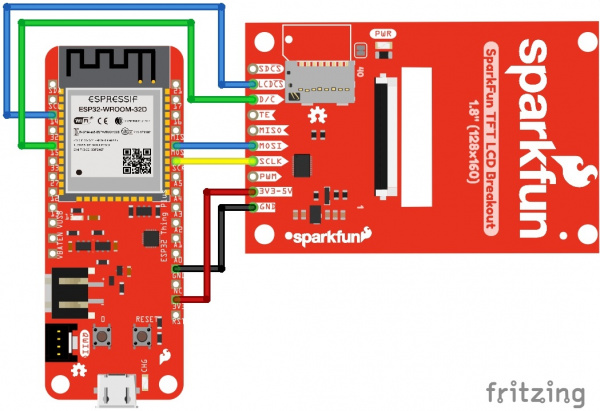TFT LCD Breakout 1.8in 128x160 Hookup Guide
Contributors:
Ell C,  Liquid Soulder
Liquid Soulder
Hardware Hookup
So you've got this breakout board with a whole bunch of pins and all you want to do is make sure it works before you write a bunch of code, right? Let's talk about the bare minimum connections required to get things working.
| Required for TFT Display | |||
|---|---|---|---|
| Breakout Pin | Arduino Uno | Esp32 Thing Plus | Microcontroller Pin Requirements |
| MOSI | 11 | 18/MOSI | Data output of chosen SPI port |
| SCLK | 13 | 5/SCK | Clock output of chosen SPI port |
| LCDCS | 5 | 14 | An output pin |
| D/C | 6 | 15 | An output pin |
| Required for microSD Card | |||
|---|---|---|---|
| Breakout Pin | Arduino Uno | Esp32 Thing Plus | Microcontroller Pin Requirements |
| MOSI | 11 | 18/MOSI | Data output of chosen SPI port |
| MISO | 12 | 19/MISO | Data input of chosen SPI port |
| SCLK | 13 | 5/SCK | Clock output of chosen SPI port |
| SDCS | 4 | 27 | An output pin |
| Completely Optional | |||
|---|---|---|---|
| Breakout Pin | Arduino Uno | Esp32 Thing Plus | Microcontroller Pin Requirements |
| PWM | 3 | 21 | An output pin, ideally PWM capable |
| TE | 7 | 17 | An input pin, ideally interrupt capable |
Please Note: In the charts above, we are using the pin numbers listed for the Arduino Uno (and similar boards) as well as the ESP32 Thing Plus, but you can choose any pin that satisfies the requirements. Just make sure to use the right pin in your code. The fastest and most re-usable way to connect your breakout is to solder in straight breakaway headers and then connect to the microcontroller using a breadboard.
